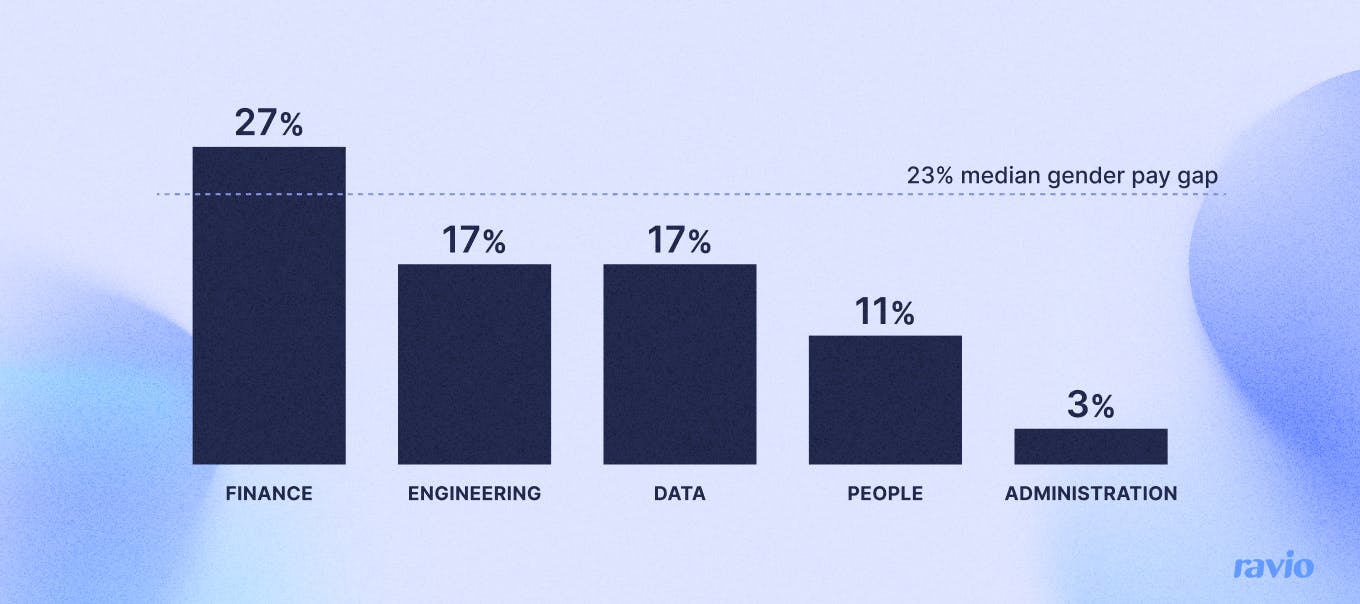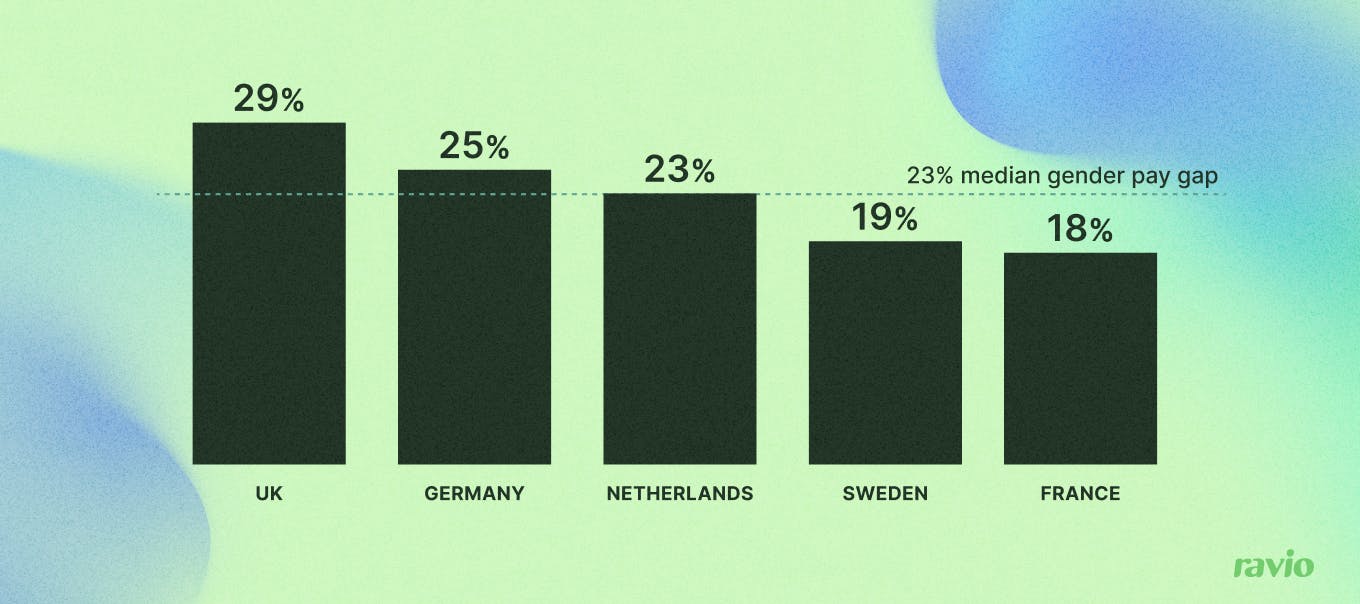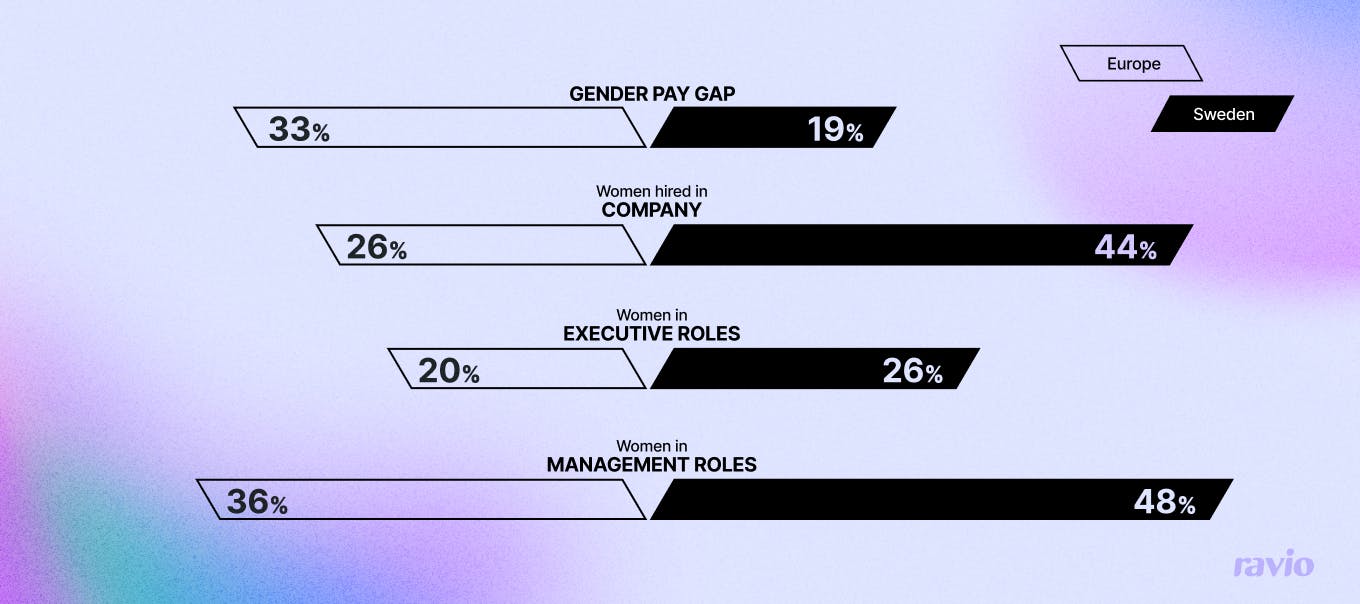The gender pay gap in the tech industry (and how to fix it in your business)

The tech industry has a big gender equality issue.
The median gender pay gap (unadjusted) in the tech industry in Europe is 23%.
That’s significantly higher than other sectors.
To put it into context, the median gender pay gap across all reporting UK companies is 9.7% (2022 data). And for EU companies the median gender pay gap is 12.7% (2021 data).
So why is gender diversity a particular problem within the tech industry?
In this article we’ll take a deeper look at gender diversity in European tech companies:
- How does the gender pay gap vary across job families?
- How does the gender pay gap vary across countries in Europe?
- What about the representation of women in leadership roles?
- Examples of three tech companies putting actions in place to improve their gender diversity – what3words, Farewill, and Team Liquid.
Subscribe to our newsletter for a monthly treasure trove of insights from Ravio's compensation dataset and network of Rewards experts, to help you navigate a career in compensation 📩
Does the gender pay gap in tech vary across job families?
The gender pay gap is highest in the following job families within the tech industry in Europe:
- Finance (27%)
- Engineering (17%)
- Data (17%) roles
This compares to, for instance, a 3% gender pay gap in administration teams or an 11% gender pay gap in people teams.

Gender pay gap variance across job families.
Does the gender pay gap in tech vary across countries?
And, the gender pay gap also varies slightly across different countries within Europe too, for example:
- UK: 29%
- Germany: 25%
- Netherlands: 23%
- Sweden: 19%
- Spain: 35%
Which is important to understand particularly if you hire across Europe.

Gender pay gap variance across countries
It’s perhaps unsurprising that Sweden’s gender pay gap is lower than other countries, given their cultural emphasis on gender equality – which feeds through to how companies approach gender diversity in their workforce.
As Mikeala Schönström, Head of People at Stockholm-based AlexisHR, put it when we chatted to her about expanding our benchmarks in Sweden:
"Sweden's impressive gender equality stats aren't just by chance. It's a mix of their strong cultural leanings towards fairness, smart government policies like shared parental leave, and an education system that pushes gender equality from the get-go. Swedish companies also deserve a nod; they're big on diversity and making sure everyone gets a fair shot.”

Head of People at AlexisHR
What about the representation of women in different roles across the tech industry?
To really understand the gender pay inequality, we can’t just look at the gender pay gap – especially when we’re looking primarily at the unadjusted gender pay gap.
It simply doesn’t tell us everything we need to know to identify systemic issues.
Another key metric to understand is the representation of women across different roles.
For European tech companies the number of women in leadership positions is very low. Women occupy just:
- 19% of executive roles
- 30% of director roles
- 35% of management roles.
Sweden is, again, a shining star in this metric.
In Sweden, 26% of executive level roles are held by women and 48% of management roles – still far from equal, but a definite improvement.

The gender pay gap and representation of women in Sweden vs Europe as a whole
Why is gender diversity such an issue in the tech industry?
Much of the problem seems to be at the point of hiring:
Ravio’s data shows that men and women have similar rates of promotion (around 7%) and pay increases (around 14%), which means gender pay inequality must exist from the start of employment for there to be such a gap.
So, what can we infer from that?
Two things:
- Women need equal opportunities to get into tech in the first place – systemic issues mean gender inequality already exists before the point of employment
- Companies can make a big difference by improving diversity and ensuring equal pay at the point of hiring.
“More men are given the opportunity to join early-stage companies and take more of the senior positions. This creates a vicious cycle where more men develop more early startup experience and become strong candidates for future roles.”

Co-founder and CPO at Ravio
Let’s look at both of these in more detail.
Women need equal opportunities to get into tech in the first place
Tech has historically been a male dominated sector.
This has led to a vicious cycle where there are limited role models for women in the sector to look up to, women aren’t advised to go into tech, and women are less likely to have aspirations to work in tech
A PwC report found that:
- 78% of students can’t name a female working in tech
- Only 16% of females have had a career in tech suggested to them as an option
- Just 3% of women have tech as their first choice career path.
Therefore, women are underrepresented in tech pathways throughout education and university – well before they climb onto the career ladder.
That makes diverse hiring very difficult for companies because the talent pool is small.
These systemic issues need addressing in education and career aspirations to ensure there is equal representation in hiring.
Organisations like Women in Tech are doing a fantastic job at driving the conversation forward – and collaboration from employers can help to accelerate this work.
Companies can make a big difference at the point of hiring
Given that diversity and pay equity is so crucial at the point of hiring, what actions can companies take?
Here’s a few suggestions:
- Make gender diversity a business priority. Often it’s simply the case that gender diversity and eliminating the gender pay gap isn’t prioritised, especially in early stage start ups and scale ups which are laser-focused on staying afloat and growing the business. But, given gender diverse teams make better decisions and therefore get better business results, there’s business incentive to make it a priority too.
- Introduce a hiring policy to have a diverse candidate pool for every role. Ensuring you have a diverse hiring funnel doesn’t take much time or money to implement. It just needs a company policy to balance the gender diversity of candidates for all roles – and especially those dominated by men traditionally. For recruiters, that likely means adjusting their outreach process e.g. posting jobs on a job board specific to women in tech.
- Include the salary range in the job description. Lack of transparency about salary range when hiring can lead to women being systematically offered lower compensation – without them being able to identify that they’re being discriminated against. This will also be mandated by the EU Pay Transparency Directive soon – so it’s always good to get ahead.
If you’re hiring for software engineering roles right now, Matchr has put together a great guide on how to hire female engineers – definitely worth a read
Examples of tech companies that are taking action to improve gender diversity and equity
As part of our Rewards Awards in 2023, we identified three tech companies that are doing a great job driving change in gender diversity in terms of hiring and compensation: what3words, Farewill, and Team Liquid.
Here’s a few examples of the actions these companies are taking to improve gender diversity and pay equity in their workforce.

what3words are addressing gender diversity by:
- Embedding diversity goals within their company mission and as a core element of the People strategy
- Optimising their interview process for best fit and employee retention
- Making job descriptions and hiring criteria much more flexible and casting the recruiting net wide – aiming to give anyone and everyone an equal opportunity to enter the process
- Introducing post-interview surveys for all applicants
“No diversity is the ultimate risk for businesses.”

Farewill are particularly focused on transparency and great communication:
- Benchmarking salaries for all employees and communicating about this, to ensure employees understand they are being paid fairly
- Ensuring all roles have a clearly defined and transparent job description and set of responsibilities
- Focusing on potential rather than level in hiring to give candidates in the early days of their career a better chance – they’ve found diverse talent is more likely to be sourced at an earlier career stage
- Hiring diversely from the word go: their first engineer hire was a woman, which has set a flywheel in motion – their tech team is 57% women today.
“Diversity is never done.”

Team Liquid are formalising diverse hiring practices, as well as focusing on community-building to improve equal opportunities in esports:
- Running a ‘women in esports’ community to create a space where women can build relationships and share challenges in a safe and open space
- Diversity as a goal which is driven both from the top down and the bottom up – the leadership team and recruiters are all driving towards the same clear direction
- A formalised policy to have at least one woman and/or person of colour in the final three candidates for all job positions
"Culture... isn’t an employee handbook or policies – it’s taking the time to listen to people, knowing who they are and not only looking at the differences, but also what they have in common."
🪜 The first step is to understand the current state of gender diversity at your company
To know which actions to take, you first need to understand the data on your gender diversity, gender pay gap, and the representation of women, so that you can identify the issues at play in your company.
There’s a lot of nuance in this topic. For instance, we previously found that in fintechs specifically the gender pay gap increases hugely as they move from growth to late stage (from 25% to 37%) suggesting that industry and funding stage also make a difference.
So, we’d suggest starting with the science – and Ravio can help with that.